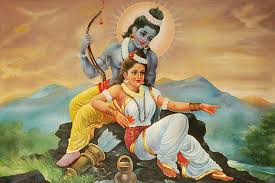

reviews [0] Festivals [7]
Ram was born for dharma stapit and get rid of adharma, at that time Ravan had acquired great power because he had obtained from god Brahma the boon that he would never die at the hands of gods, or gandharvas, or yakshas (demigods) or demons. As he was not afraid of men he did not care to include men in the list of his potential slayers. So Brahmadev declared that Ravan would die at the hands of a man. Then the gods went to Vishnu with the request, "Dasarath is a glorious king. Please, take birth in the wombs of his three queens in four different degrees of your divinity."
When Dasarath's sacrifice came to an end a shining figure appeared over the sacrificial kund, and offered the king a divine beverage called "payasam" to be given to his queens Kausalya, Kaikayi, and Sumitra. In due time Kausalya gave birth to Rama, Kaikayi to Bharat and Sumitra to Laxman and Shatrugna. Rama was born at noon of the bright ninth day of Chaitra. He was believed to be the embodiment of half degree of Vishnu's divinity.
Rama Navami falls on the ninth day of the shukla paksha, or bright phase of the moon, in the lunar month of Chaitra (April-May). The first day of Chaitra, also marks the beginning of the Indian year.
Rama is one of the ten avatars of Lord Vishnu, and one of the two most popular, along with Krishna. Consequently, Rama Navami is widely celebrated.
According to Shastras, Rama was born at noon. Rama is the epitome of perfection, the uttama purusha, fulfilling all his duties towards both family and subjects.
Rama was the first of the four sons of King Dasharatha of Ayodhya. When it was time for Rama to be made crown-prince, his stepmother, Kaikeyi, got Dasharatha to send him to the forest for 14 years. His wife Sita and his brother Lakshmana also accompanied him. In the forest, Sita was kidnapped by Ravana, the demon king of Lanka. Rama, together with Hanuman and the monkey army, built a bridge to Lanka, killed Ravana, and brought Sita back.
It is believed that listening to the story of Rama cleanses the soul. Meditating on the noble Rama and chanting his name is believed to ease the pains of life and lead one to moksha, or liberation.
Significance:
Though Rama Navami is a major festival for Vaishnavites, it is widely celebrated by worshippers of Shiva, too. It is considered auspicious to undertake a fast on the day in the name of Rama.
The more devout fast for nine days, from Pratipadha tithi to Rama Navami. The objective of the fast is not to ask for special favours of the deity but to seek perfection as a human being. Devotees perform elaborate pujas and chant the name of Rama. Temples of Rama have special services and bhajan sessions through the day.
One significant and popular element of the celebration is the Ramayana parayana, a discourse on the Ramayana, by a pundit or a professional story-teller. It usually lasts nine days, beginning on Pratipadha tithi and ending on Rama Navami.
Since Rama is also one of the most sung-about deities in Indian classical music and literature, week-long (and sometimes, month-long) musical programmes are organised.
Sacred places associated with Rama, like Ayodhya, Ujjain and Rameshwaram, draw tens of thousands of devotees. In Rameshwaram, thousands take a ritual bath in the sea before worshipping at the Ramanathaswamy temple.











